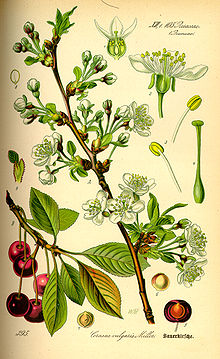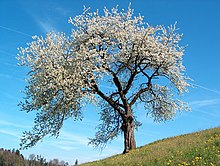Prunus cerasus
| Prunus cerasus | |
|---|---|

| |
| 1897 illustration[1] | |
| Scientific classification | |
| Kingdom: | Plantae |
| Clade: | Tracheophytes |
| Clade: | Angiosperms |
| Clade: | Eudicots |
| Clade: | Rosids |
| Order: | Rosales |
| Family: | Rosaceae |
| Genus: | Prunus |
| Subgenus: | Prunus subg. Cerasus |
| Species: | P. cerasus
|
| Binomial name | |
| Prunus cerasus L. 1753
| |
| Synonyms[2] | |
|
List
| |
Prunus cerasus (sour cherry,[3] tart cherry, or dwarf cherry[4]) is a species of Prunus in the subgenus Cerasus (cherries), native to much of Europe, North Africa and West Asia. It is closely related to the sweet cherry (Prunus avium), but has a fruit that is more acidic. Its sour pulp is edible.[5]
The tree is smaller than the sweet cherry (growing to a height of 4–10 m), has twiggy branches, and its crimson-to-near-black cherries are borne upon shorter stalks. There are two main varieties (groups of cultivars) of the sour cherry: the dark-red Morello cherry and the lighter-red Amarelle cherry.[6]
Origins and cultivation[edit]


Prunus cerasus, a tetraploid with 2n=32 chromosomes, is thought to have originated as a natural hybrid between Prunus avium and Prunus fruticosa in the Iranian Plateau or Eastern Europe where the two species come into contact. Prunus fruticosa is believed to have provided its smaller size and sour tasting fruit. The hybrids then stabilized and interbred to form a new, distinct species.[7]
Cultivated sour cherries were selected from wild specimens of Prunus cerasus and the doubtfully distinct P. acida from around the Caspian and Black Seas, and were known to the Greeks in 300 BC. They were also used by Persians and the Romans who introduced them into Britain long before the 1st century AD[citation needed]
In England, their cultivation was popularized in the 16th century in the time of Henry VIII. They became a common crop amongst Kentish growers, and by 1640 over two dozen named cultivars were recorded.[citation needed]
Before the Second World War there were more than fifty cultivars of sour cherry in cultivation in England; today, however, few are grown commercially, and despite the continuation of named cultivars such as 'Kentish Red', 'Amarelles', 'Griottes' and 'Flemish', only the generic Morello is offered by most nurseries. This is a late-flowering variety, and thus misses more frosts than its sweet counterpart and is therefore a more reliable cropper. The Morello cherry ripens in mid to late summer, toward the end of August in southern England. It is self-fertile, and would be a good pollenizer for other varieties if it did not flower so late in the season.[citation needed]
Sour cherries require similar cultivation conditions to pears, that is, they prefer a rich, well-drained, moist soil, although they demand more nitrogen and water than sweet cherries. Trees will do badly if waterlogged, but have greater tolerance of poor drainage than sweet varieties. As with sweet cherries, Morellos are traditionally cultivated by budding onto strong growing rootstocks, which produce trees too large for most gardens, although newer dwarfing rootstocks such as Colt and Gisella are now available. During spring, flowers should be protected, and trees weeded, mulched and sprayed with natural seaweed solution. This is also the time when any required pruning should be carried out (note that cherries should not be pruned during the dormant winter months). Morello cherry trees fruit on younger wood than sweet varieties, and thus can be pruned harder. They are usually grown as standards, but can be fan trained, cropping well even on cold walls, or grown as low bushes.[8]
Sour cherries suffer fewer pests and diseases than sweet cherries, although they are prone to heavy fruit losses from birds. In summer, fruit should be protected with netting. When harvesting fruit, they should be cut from the tree rather than risking damage by pulling the stalks.[citation needed]
Unlike most sweet cherry varieties, sour cherries are self fertile or self pollenizing (sometimes inaccurately referred to as self-pollinating). Two implications of this are that seeds generally run true to the cultivar, and that much smaller pollinator populations are needed because pollen only has to be moved within individual flowers. In areas where pollinators are scarce, growers find that stocking beehives in orchards improves yields.[8]
Production[edit]
| 297,200 | |
| 183,800 | |
| 180,240 | |
| 176,770 | |
| 164,446 | |
| 134,055 | |
| 110,770 | |
| World | 1,593,025 |
In 2022, world production of sour cherries was 1.6 million tonnes, led by Russia with 19% of the total (table). Other major producers were Poland, Ukraine, and Turkey.
Uses[edit]
Culinary[edit]
Dried sour cherries are used in cooking including soups, pork dishes, cakes, tarts, and pies. Also used to make a jam/fruit spread.[citation needed]
Sour cherries are particularly common in Turkey, especially in the form of vişne suyu (sour cherry nectar), a widely-consumed beverage, and vişne reçeli (sour cherry jam), often eaten as part of a traditional breakfast or mixed into plain yoghurt.[citation needed]
Sour cherries or sour cherry syrup are used in liqueurs and drinks, such as the Romanian vișinată or the Portuguese ginjinha. In Iran, Turkey, Greece and Cyprus, sour cherries are prized for making spoon sweets by slowly boiling pitted sour cherries and sugar; the syrup thereof is used for sharbat-e Albalou, vişne şurubu or vyssináda, a beverage made by diluting the syrup with ice-cold water. A particular use of sour cherries is in the production of kriek lambic, a cherry-flavored variety of a naturally fermented beer made in Belgium.[10][11] In Germany and Austria, sour cherries are used for desserts such as the donauwelle.
Gallery[edit]
-
Worldwide sour cherry production, 2024
-
Ripe sour cherries, Hungary
-
Ripe sour cherries and their leaves, Iran
-
Sour cherries
-
Kriek lambic is infused with sour cherries
See also[edit]
- Fruit tree propagation
- Ginjinha, a Portuguese liqueur made from sour cherries
- Griotte de Kleparow
- Kirsch
- Kriek, a traditional Belgian beer made with sour cherries
- Marasca cherry (Prunus cerasus var. marasca)
- Amarena cherry (Prunus cerasus var. amarena)
- North Star cherry, a dwarf variety
- Pruning fruit trees
- Sour cherry soup
- Syzygium corynanthum, an Australian rainforest tree also known as the sour cherry
- Vișinată, a Romanian liqueur made with sour cherries (vișina in Romanian)
References[edit]
- ^ illustration from Franz Eugen Köhler, Köhler's Medizinal-Pflanzen 1897
- ^ "The Plant List: A Working List of All Plant Species". Retrieved January 27, 2014.
- ^ USDA, NRCS (n.d.). "Prunus cerasus". The PLANTS Database (plants.usda.gov). Greensboro, North Carolina: National Plant Data Team. Retrieved 14 October 2015.
- ^ BSBI List 2007 (xls). Botanical Society of Britain and Ireland. Archived from the original (xls) on 2015-06-26. Retrieved 2014-10-17.
- ^ Little, Elbert L. (1980). The Audubon Society Field Guide to North American Trees: Eastern Region. New York: Knopf. p. 498. ISBN 0-394-50760-6.
- ^ Webster’s New International Dictionary of the English Language. Springfield, Massachusetts: G. & C. Merriam Co., 1913. See amarelle at p. 67.
- ^ Stocks, Christopher (2009). "Britain's forgotten fruits". Flora. 1: 1–200.
- ^ a b "Growing cherries" (PDF). Michigan State University, Extension-Oakland County. 2012. Archived from the original (PDF) on 2017-02-02. Retrieved 2016-11-01.
- ^ FAOSTAT of the United Nations"Production of sour cherries in 2022; Pick lists by Crops/Regions/Production Quantity/Year". United Nations, Food and Agriculture Organization Corporate Statistical Database. 2024. Retrieved 10 July 2024.
- ^ Jackson, Michael (1997). The Simon Schuster Pocket Guide to Beer. Simon and Schuster. p. 80. ISBN 978-0-684-84381-0.
- ^ "Guinda". Frutasdelbosque.org (in Spanish). 28 September 2021.






